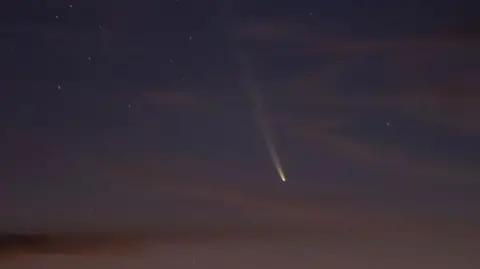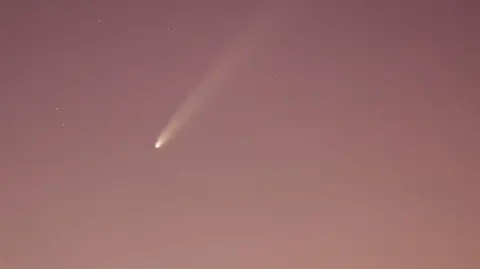How to spot ‘comet of the century’ in UK skies
 Getty Images
Getty ImagesA comet that was seen from Earth last month for the first time in 80,000 years might be visible with the naked eye in the UK on Saturday evening, according to the Royal Astronomical Society (RAS).
The society said Comet A3 (Tsuchinshan-ATLAS) has been called the “comet of the century” because of how bright and visible it can be.
On Saturday the comet is expected to come within about 70 million km (44 million miles) of Earth, according to the Nasa Earth Observatory.
The RAS’s Dr Robert Massey told BBC News that Saturday night was the “opening of the window to try” and see the comet in the UK.
Head for higher ground and look west
He said people should go out “immediately after sunset” with a pair of binoculars, head for higher ground and look west towards the horizon.
Try to stand where hills, buildings and trees are not blocking your view, he said.
Skies will be clearing overnight on Saturday as strong winds push the cloud and showers away into the North Sea.
Dr Massey advised people to “wrap up” and bring a hot drink with them.
“Just go out, enjoy it, don’t sweat it,” he said.
The RAS said the comet was first visible in the southern hemisphere between 27 September and 2 October and would be visible from Saturday night to 30 October.
The comet likely travelled from the outer reaches of our solar system and made its closest transit past the sun on 27 September, the Nasa Earth Observatory said.
Dr Massey said the nucleus of the comet – its solid core – has been estimated to be 2km (1.24 miles) long, or “mountain-size”.
He said he tried to spot it on Friday night and will “certainly try again”.
“Sometimes comets disappoint… but this one appears to be acting in line with predictions,” he said.
“We want people to try and go out and have a look.”
 Reuters
ReutersHow to photograph the comet
Comet A3 (Tsuchinshan-ATLAS) was photographed in Spain, Italy, Uruguay, and Indonesia between 29 September and 1 October.
Dr Massey advised using a DSLR camera to capture the comet, but said holding a mobile phone camera up against the eyepiece of a small telescope could snap the space event too.
“And if it’s genuinely easy to spot, you might, might be able to pick up your mobile phone, rest on something, and just point and shoot,” he said.
The comet follows the UK’s skies being splashed with colour from the Northern Lights overnight on Thursday.
The lights, also known as aurora borealis, were expected to be seen only as far south as the Midlands, but the spectacle was visible from the top of the UK in the Shetland Islands down to London.
Is there a link between the comet and the Northern Lights?
“It’s a nice coincidence,” Dr Massey said.








